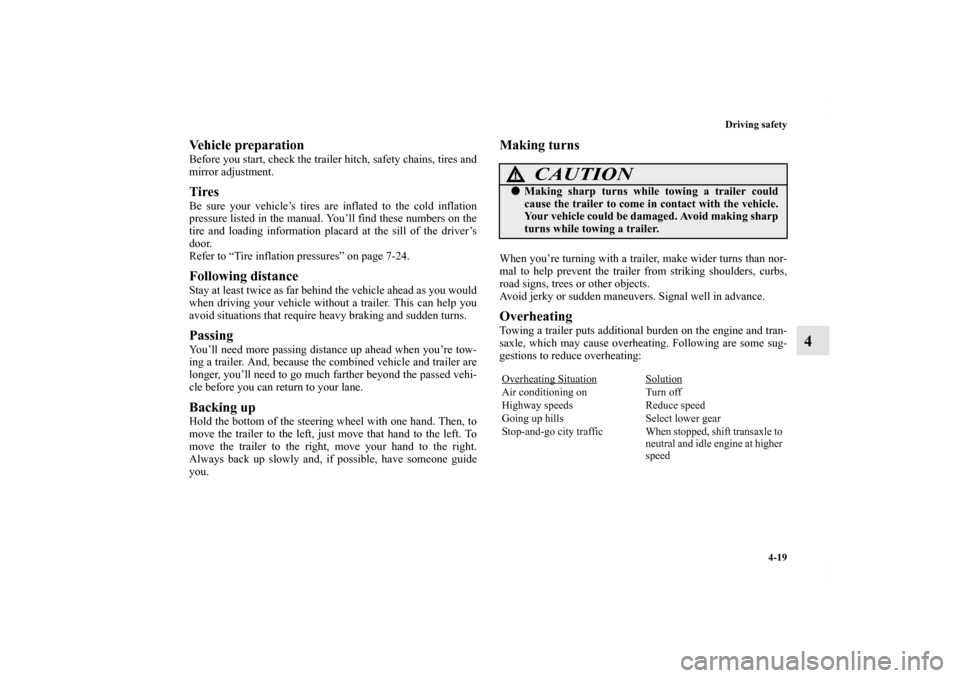Page 118 of 514
Features and controls
3-29
3
To releaseHold the brake pedal (A) down with your right foot.
Depress the parking brake pedal (B) by your left foot again
until you hear it “click”.
When parking on a hill, apply the parking brake and turn the
front wheels toward the curb on a downhill grade, away from
the curb on an uphill grade.
Steering wheel tilt lock lever
N00511500097
To adjust the steering wheel height, release the tilt lock lever
while holding the steering wheel by hand, and raise or lower
the steering wheel to the desired height.
After adjustment, securely lock the lever by pulling it down-
ward.
CAUTION
!�Before driving, be sure that the parking brake is
fully released and brake warning light is off.
If a vehicle is driven without releasing the parking
brake, the brakes will be overheated, resulting in
ineffective braking and possible brake failure.
1- Locked
2- Released
BK0102600US.book 29 ページ 2009年3月30日 月曜日 午後2時2分
Page 119 of 514
3-30 Features and controls
3Inside day/night rearview mirror
N00511600216
Adjust the inside rearview mirror only after making any seat
adjustments so as to have a clear view to the rear of the vehicle.
WA R N I N G
!�After adjusting, make sure the lock lever is secured
in the locked (1) position. �Do not attempt to adjust the steering wheel while
driving. This can be dangerous.�When releasing the tilt lock lever {moving it to the
position (2)}, be sure to hold the steering wheel
firmly. Otherwise, the steering wheel may slip down
too suddenly.
WA R N I N G
!�Do not attempt to adjust the inside rearview mirror
while driving. This can be dangerous.
Be sure to adjust the mirror before driving.
BK0102600US.book 30 ページ 2009年3月30日 月曜日 午後2時2分
Page 318 of 514

Driving safety
4-19
4
Vehicle preparationBefore you start, check the trailer hitch, safety chains, tires and
mirror adjustment.TiresBe sure your vehicle’s tires are inflated to the cold inflation
pressure listed in the manual. You’ll find these numbers on the
tire and loading information placard at the sill of the driver’s
door.
Refer to “Tire inflation pressures” on page 7-24.Following distanceStay at least twice as far behind the vehicle ahead as you would
when driving your vehicle without a trailer. This can help you
avoid situations that require heavy braking and sudden turns.PassingYou’ll need more passing distance up ahead when you’re tow-
ing a trailer. And, because the combined vehicle and trailer are
longer, you’ll need to go much farther beyond the passed vehi-
cle before you can return to your lane.Backing upHold the bottom of the steering wheel with one hand. Then, to
move the trailer to the left, just move that hand to the left. To
move the trailer to the right, move your hand to the right.
Always back up slowly and, if possible, have someone guide
you.
Making turnsWhen you’re turning with a trailer, make wider turns than nor-
mal to help prevent the trailer from striking shoulders, curbs,
road signs, trees or other objects.
Avoid jerky or sudden maneuvers. Signal well in advance.OverheatingTowing a trailer puts additional burden on the engine and tran-
saxle, which may cause overheating. Following are some sug-
gestions to reduce overheating:
CAUTION
!�Making sharp turns while towing a trailer could
cause the trailer to come in contact with the vehicle.
Your vehicle could be damaged. Avoid making sharp
turns while towing a trailer. Overheating Situation
Solution
Air conditioning on Turn off
Highway speeds Reduce speed
Going up hills Select lower gear
Stop-and-go city traffic When stopped, shift transaxle to
neutral and idle engine at higher
speed
BK0102600US.book 19 ページ 2009年3月30日 月曜日 午後2時2分